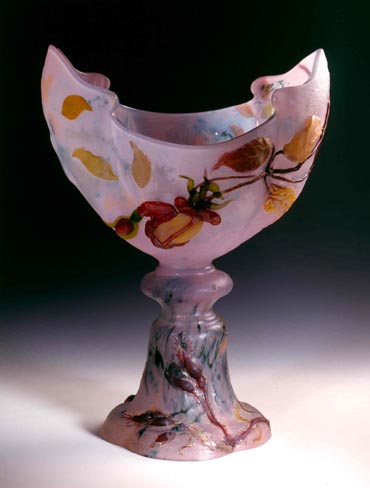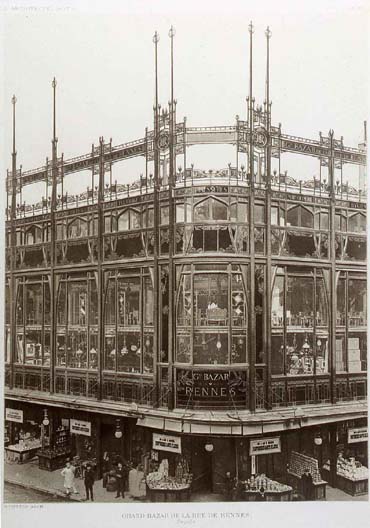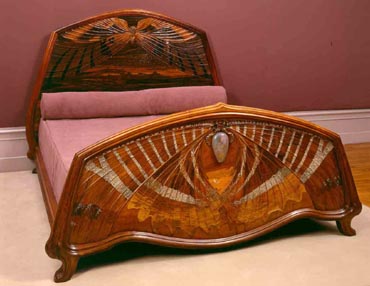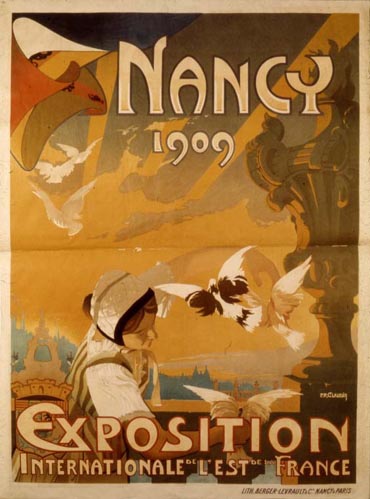|

ref:2007/1
(2)
Émile
Gallé and nature: types and influences in his glass
Valérie
Thomas
Conservateur, Musée de l'Ecole de Nancy

Abstract
This
article explores the importance of the botanical world for
Émile Gallé. This fascination, begun in childhood,
grew throughout his life and led the artist to help found
the Société Centrale d'horticulture de Nancy,
of which he was the Secretary, and to establish links with
eminent botanists and horticulturists. In his glass, Gallé
delved into a repertoire of botanical forms to create new
decorative motifs and new object shapes. Far from a servile
imitation, Gallé used the natural world as a point
of departure for formal and aesthetic experimentation, realised
and translated into glass by subtle effects of the medium.


ref: 2007/1 (3)
Selling
Art Nouveau in the Capital: The Nancy School in Paris
Robert
Proctor
Glasgow School of Art

Abstract
The
Art Nouveau products created by the Nancy School were conceived
of in relation to their market, a market conveniently provided
by the branches of the Magasins Réunis department store
in the Lorrain region, operated by by Eugène Corbin.
From 1894, the company opened three very different stores
in Paris, designed and created by architects and craftsmen
from Nancy with the intention of selling their work to a wider
public. This article examines these buildings, as far as the
limited sources and surviving structures allow, and by placing
them within a wider context of architectural ideas in the
capital, will suggest the extent of their influence upon contemporary
architects. These buildings also allow us to see how the Nancy
craftsmen placed their work in relation to its audience, both
in the microcosm of the store building, and within the city:
it is significant, for example, that Gallé refused
to sell in these stores, and sent his work to a specialist
shop near the Opéra to attract an international clientèle.
That three stores were felt to be necessary was partly a consequence
of their locations, each intended to appeal to a different
market, a fact which may partly explain their distinctive
designs. Finally, the paper will look briefly at related work
in Paris by Henri Sauvage, particularly his workshops for
Louis Majorelle, from the period of transition towards Art
Deco, and perhaps in response to Corbin’s fateful change
of taste after the First World War.


ref:
2007/1 (4)
'Ma
racine est au fond des bois': Gallé and Wood
Claire
O'Mahony
Department of Continuing Education and Kellogg College, University
of Oxford

Abstract
Described
by Roger Marx as ‘homo-triplex,’ Gallé
experimented tirelessly with the expressive potential of ceramics,
glass and wood. However, his furniture has received much less
critical attention than his work in glass. By examining Gallé’s
unique engagement with the distinctive possibilities and effects
of wood as a medium, one recognises more fully the degree
to which natural forms provided him with dynamic structures
and aesthetic complexity, as well as surface decorative effects.
Gallé’s nuanced writings on furniture design,
his report to the jury of the 1889 Exposition Universelle
‘Notice sur la production de menuiserie et ébénisterie
sculptées et marquetées d’É Gallé’
and a pair of articles first published in La Revue des Art
Decoratifs in 1900 ‘Le Mobilier contemporain orné
d’après la nature’, offer helpful insights
into the vexed issue of Gallé’s relationship
to mechanisation and artisanal ideals. Gallé’s
essays assist in recontextualising his furniture within the
distinct attitudes and methods of the French tradition of
ébenisterie, which was elucidated by the sociological
studies of the trade undertaken by Pierre De Marroussem in
the 1890s. Our understanding and involvement with Gallé’s
work in wood can be deepened, not only by more nuanced consideration
of these more technical concerns, but also by devoting more
attention to the political and poetic iconography of the pieces
themselves, which reveals Gallé’s deeply committed
social activism, an issue which still remains at the periphery
of much of the critical analysis of his oeuvre.


ref:2007/1
(5)
The
1909 Nancy International Exhibition: Showcase for a Vibrant
Region and Swansong of the Ecole de Nancy
Béatrice
Damamme-Gilbert
Department of French Studies, University of Birmingham

Abstract
In 1909, five years
after Émile Gallé's death and five years before
Europe embarked on its bloodiest war ever, the town of Nancy
- then only forty kilometres away from the border with Germany
- hosted what was to prove an amazingly successful international
exhibition: L'Exposition Internationale de l'Est de la France.
This was to demonstrate to the world that the region had recovered
from the painful loss of Alsace and Eastern Lorraine in 1870
and could now take pride, through the flourishing of both
Industry and Art, in its booming economy and sophisticated
culture. This paper will examine how the exhibition came to
be held and what were its objectives and main exhibits, commenting
particularly on the style of the main pavilions, the débâcle
surrounding the Ecole de Nancy pavilion and the relationship
between art and industry. It will go on to highlight, through
an examination of the ideological and allegorical discourse
and the iconography surrounding the exhibition, the particular
place occupied by Lorraine in the nation's self-representation.

|
|

